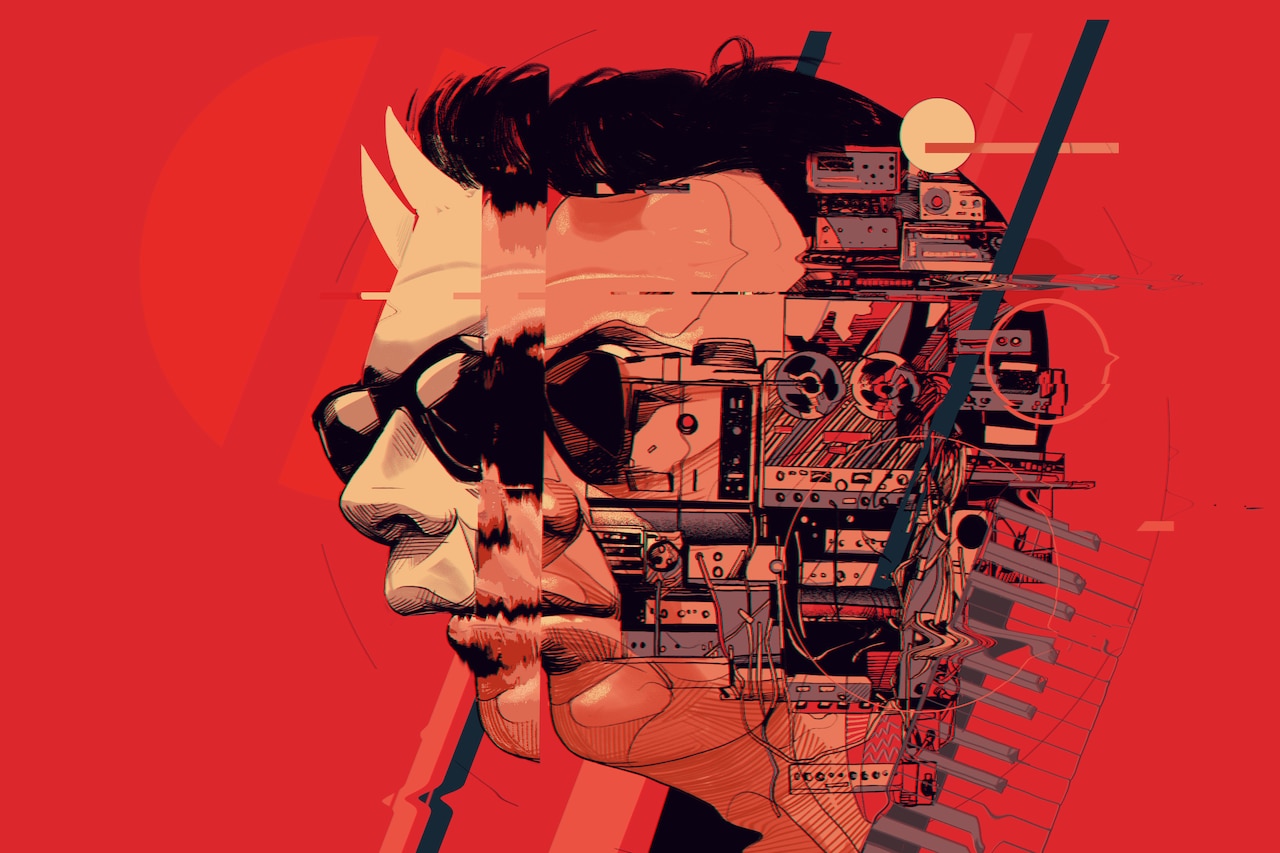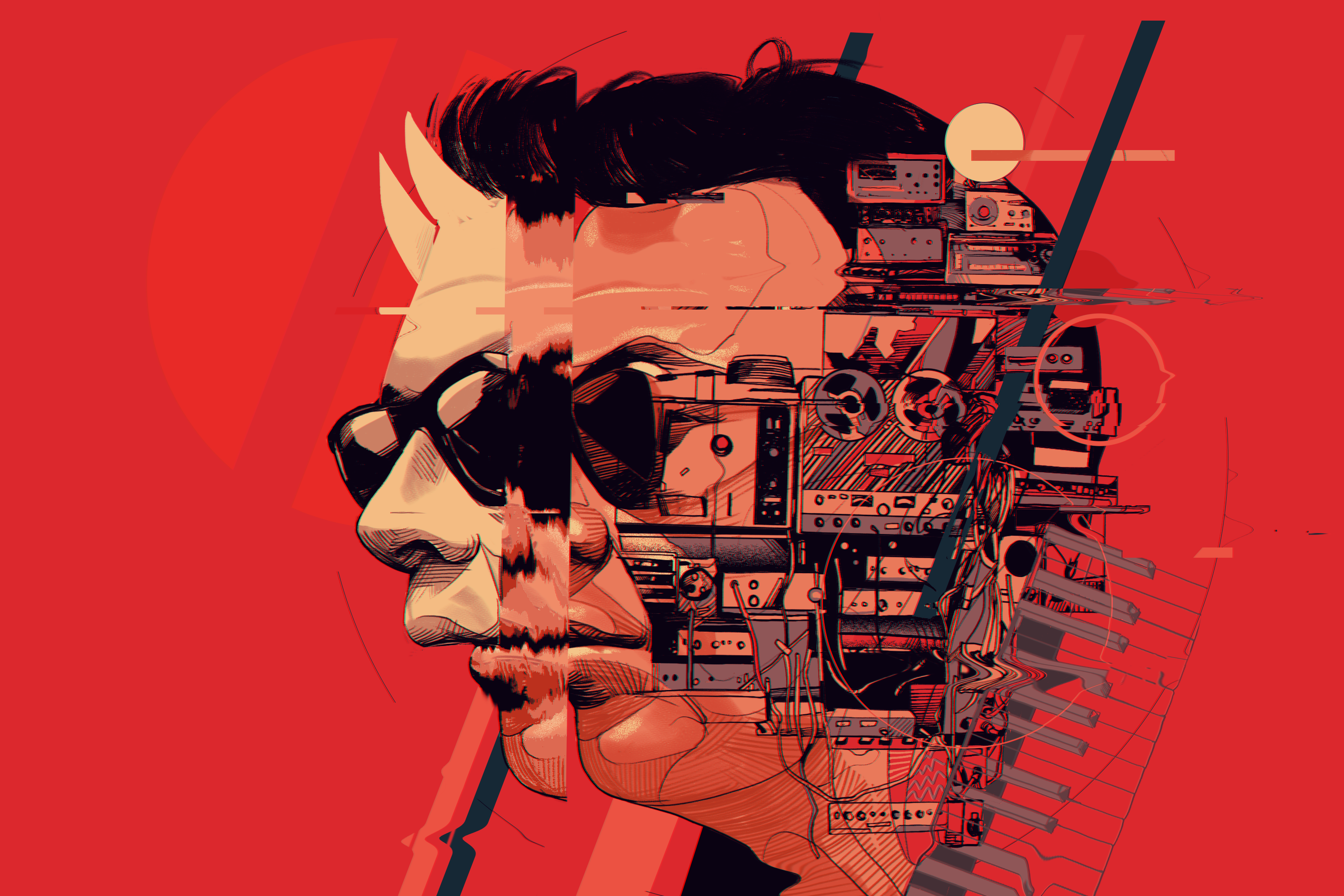
Bruce Haack
The pioneers of electronic music are always recast as retrofuturists. They are the aural equivalent of UFOs, arcologies and little green men, bitten off and sampled as the sound of quaint idealism or kitsch space travel. But as much as we associate proto-synthesizers with the sound of a fictional future, Bruce Haack was not concerned with fiction.
The Canadian iconoclast craved an audience with science, children, rock & rollers and any free spirit who would come along with him on his quest for new sound. Haack was an inventor and explorer, an indescribable mind programming and composing the future. Through a life that included Juilliard, inventing an early version of the vocoder, a trip to Mr. Rogers’ neighborhood and peyote, Haack turned the fiction of computers making music into a reality.
It would be wrong to say Haack made this music exclusively for kids. In truth he was making music for the inner child, the dreamer inside of all of us.
It was in the isolated Alberta mining town of Rocky Mountain House where Haack first started searching for a new dimension. Born in 1931 as the only child of an abusive mother and father who died young of polio, Haack became an autodidact, teaching himself to play piano by age four, and in turn teaching others the instrument by age 12. By all accounts he had perfect pitch, and was able to play back any tune after only hearing it once.
Naturally, he applied to the music school at the University of Alberta, but was denied admission to the program because he could not sight-read music. So instead, he studied psychology while playing piano and gigging in his free time. Someone at New York’s Juilliard School took notice of Haack’s work, and soon after, Haack was on his way to Manhattan in 1954 with an acceptance letter and, as he put it, “a chicken sandwich and 60 dollars.”
Now, no origin story about Haack has been written without noting that at some point as a young child, he would occasionally sneak off with the local First Nations tribe and sit in on their pow-wows and smoke peyote. It sounds crazy, but it adds to the mythos – and presages his struggle with drugs and alcohol later in his life. Whether it was true or not, it certainly retrofits a shocking origin story for a savant who wired synthesizers to connect himself to a spiritual afterworld.
Haack was not long for the rigid structure of Juilliard, dropping out only after 18 months. As a penniless musician in New York, he tried his hand at composing scores for operas and incidental music at various theaters, as well as writing several musique concréte compositions. But nothing was turning him into a career musician. And he was still penniless. So to make ends meet, he put his piano skills to work and began to play accompaniment for the dance class of a woman named Esther Nelson. The pair would eventually link up with an old Juilliard pal of Haack’s by the name of Ted Pandel, and the three of them would compose together, on various projects, eventually forming the label Dimension 5.
It was then that Haack’s music career began in earnest. Without any engineering or electronic background, Haack would gut radios and build equipment. “Bruce would go to Grand Street and buy a bag of parts for a dollar and build instruments with them for us to record with,” Nelson told L.A. Weekly in a recent story. What began as light tinkering eventually morphed into bona fide inventions. During this period, Haack created something called the Peopleodian, an analog synthesizer that ran on just a nine-volt battery and was used to play tones and pitches on people. Victor Borge laughed it up on the old variety game show I’ve Got A Secret in 1966, demonstrating Haack’s invention on an octave of women (Haack and Pendel are introduced briefly at the end of the segment).
This was only the beginning of Haack’s foray into electronic innovation. He would go on to invent the Mr. C, an analog synthesizer in the form of a robot programmed to play music for live audiences; The Musical Computer, a home-built digital/analog synthesizer and digital sampler encased in a suitcase that used sensors and skin touch to trigger lights and sounds; and most importantly, the Farad, a motion-controlled vocoder, named after Michael Faraday. The Farad was the commercially used vocoder, the one that wasn’t used by the military to mask voices over comm channels.
The vocoder takes the human voice and disassembles it, turning it into a series of digital signals. That also serves as a fitting description of Haack’s creative process as he began to record music with Nelson and Pendel in an ad hoc apartment studio in Manhattan. First came the children’s albums, which were called Dance, Sing and Listen (1963), Dance, Sing and Listen Again (1964) and, yes, Dance, Sing and Listen Again & Again (1965). By even the most liberal standards, these were fucked up kid’s songs, the kind many parents would want to slowly usher their children away from.
But the best part about Haack’s music is that it wasn’t gee-golly pandering to little kids. They were there to flick the imagination. Just to get a taste of what he was doing with children’s music, imagine you’re a doe-eyed young kid and listen to “Soul Transportation” or the honestly quite lovely “Saint Basil.” It was in part these children’s records that landed him, strangely enough, on Mr. Rogers Neighborhood in 1967.
There was Haack, stiff as a board, looking like Eddie Munster if he started selling used cars, sampling the Rolling Stones’ song “Citadel,” singing a song about magical wheels while some kids dizzy themselves to the floor. If anyone was a Kraftwerk for kindergarteners, it was Haack.
It would be wrong to say Haack made this music exclusively for kids. In truth he was making music for the inner child, the dreamer inside of all of us. This ideology would align well with the zeitgeist of the early ’70s, and with the peak of his career both commercially and artistically. That’s when Haack released his first album not specifically aimed for kids, his acid-drenched 1970 major label debut, Electric Lucifer. The record was fluent in the far-out wavelength of both avant-garde electronics and anti-Vietnam protest music. It was an epic album, Wagnerian in scope. Haack references some extra-planar war between Evil and Love, and obviously Satan is involved, too. Recorded and produced entirely by Haack, the album is considered the toast of his career, and saw modest success across college and AM radio.
As his career pressed on, Haack drew inward, a troubled man falling into drugs and alcohol. His 1977 work Haackula is a psychosexual critique of staid society, and his final album, 1981’s Bite gets at similar things, only without a song called “Blow Job.” While Dimension 5 continued to release trippy synth records, Haack’s music career slowed as his health ailed. Stunningly, in 1982, he and Def Jam’s Russell Simmons recorded an ur-rap song called “Party Machine.” It would be his swan song. Haack died of heart failure in 1988.
When you think of pioneers, names like Jean Michel Jarre, Kraftwerk, Stockhausen, Raymond Scott, Wendy Carlos and Giorgio Moroder come to mind as “those who did it first.” While Haack may not have carried the pedigree or influence as those mentioned, much as the 2004 documentary about his life The King of Techno would like to imply, what sustains Haack’s legacy is his commitment to wonder.
It’s no wonder he’s sampled by likeminded explorers like J Dilla and Stones Throw cohort Blockhead. (Stones Throw honored Bruce Haack by putting out a compilation of songs that featured Haack and his Farad, as well as a whole set of remixes featuring Peanut Butter Wolf, James Pants and more.)
More than heady electronic compositions, club-rousing beats or lysergic rock & roll, Haack’s legacy leans more on his curiosity, and the childlike spirit that he donated to his generation and those who came after. Imbued in Haack’s music is something that may sound corny nowadays, but just like the space program, Haack tried to capture the fascination with a dimension that was beyond what we knew to be true.
Header image © Oliver Barrett
